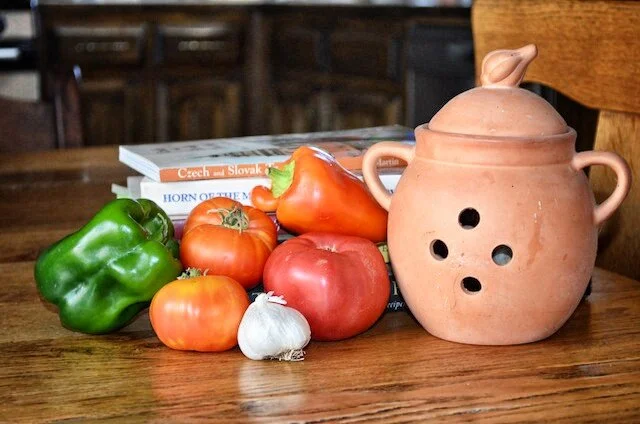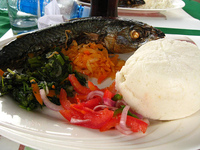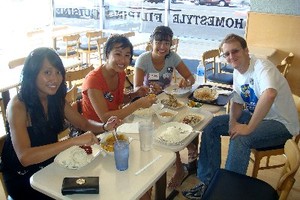When long lines and growling stomachs force Laurie Gilberg Vander Velde and her husband to abandon their plans to eat at a famous Naples pizzeria, serendipity delivers something even better.
All tagged Culinary travel
The dog's tail wagged impatiently. Lady -- a small, nondescript, white and brown mutt -- raced ahead to the oak tree, sprinted back and forth, nose thrust into the ground, then triumphantly started digging with gusto. Looking up with an air of satisfaction, Lady was handsomely rewarded before her master carefully scraped the loosened dirt with his pick. The five visitors observing the ritual looked on expectantly. Using his fingers to gingerly explore further, the truffle hunter delicately removed his treasure: a large, walnut-size white truffle, one of the epicurean riches of Alba, a gem of a city in the Piedmont region of northwest Italy.
Okay, let me just say that up to now the closest I had come to a truffle was in a Whitman’s Sampler box and it was covered with chocolate. And I’m pretty sure it had never been routed out by a dog. This truffle hunting is a respected art form in Alba, and proper training of the dogs is at its heart. Any breed can aspire to the job, but selection depends upon its resume. It must have a good nose (a trait the dogs presumably share with the region's prestigious wines), and trainers can ascertain that after three days. Once the dogs show promise, they attend the Barot University of Truffle Hunting Dogs, in operation since 1880, for two to three months of specialized training. Graduate school is optional.
Now let's talk truffles. Sure, to the uninitiated, it may just be a foul fungus, but to the gourmand, it represents the ultimate in gastronomic delights. It is judged by size, color, shape, texture, aroma - some would say offensive olfactory onslaught; others, fragrance of the gods -- and its overall perfection. There's a lot to be said for this smelly little mushroom.
Adventures of a Cookbook Traveler
by Dorty Nowak
I collect cookbooks the way others collect travel books. More than souvenirs of places I have been, they help me recreate memories and whet my appetite for further trips. Over the years, I’ve accumulated an impressive library, with Europe, Asia and the Americas grouped together on my bookshelf. When I open Provence, the Beautiful Cookbook, and look at a picture of glossy tomatoes clustered with deep green zucchinis, papery garlic, and branches of rosemary I can taste the wonderful ratatouille I had in Nice, and I’m there once again.
I developed a taste for culinary travel early. My mother, who hated to cook, had a limited repertoire, which reflected her German-Irish roots. Meat, potatoes and vegetables cooked to a uniform grey were standard fare and I could usually predict what we would have for dinner by the day of the week. The Joy of Cooking was the mainstay of her library. It was, and is, a no-nonsense compendium of recipes, with no pictures to grace its pages. When I was fortunate to travel to Europe in college, the pleasure of sampling new foods and the beautifully illustrated cookbooks I collected were almost as exciting as touring the sights.
Omnivore’s Revenge
by Jules Older
I am not a vegetarian.
 I say it with pride: I am not a vegetarian.
I say it with pride: I am not a vegetarian.
But I live with a vegetarian — well, a mostly vegetarian, and when the vegetarian’s daughters (and mine) come home, then we get into serious vegetarianism. Because I'm outnumbered, three to one.
Now, I have nothing — well, almost nothing — against vegetarianism. It’s true, I think the best diet is a richly diverse one. And it’s true that I think everything about us, from our taste buds to the shape of our teeth to our digestive systems, indicates that we are built for eating meat as well as tofu.
But at home, I'm more likely to get tofu.
That’s why it gave me such pleasure when the editor of Vermont Magazine called and said, “Jules, m’boy, we’d like you to get yourself down to Windsor. Write us a story on the New England BBQ Championships.”
And I was even happier when he added, “Oh, and bring the vegetarian photographer with you.”
Payback’s a brisket.
I am not one of those Americans for whom a familiar breakfast serves as a security blanket. You know what I mean. “I must have fresh ground coffee.” “I have to start the day with a three-minute egg. Don’t those people have an egg timer?”
I welcome that plunge into local culture, as, not quite full conscious, I am confronted with something on a plate or in a bowl that seems, well, foreign.
How to Eat Breakfast around the World
1. New Zealand
Baked beans. Okay, get over it. Beans are a good source of protein, have a touch of sweetness, and the fiber equivalent of stewed prunes. The milk for your tea will be down the hall in the hotel in a small fridge.
2. Austria
Loosen your belt. Several times a day, stop in a café for Austria’s favorite sport—piling schlag (whipped cream) on coffee mit chocolate mit maybe a slurp of rum. But that is not for breakfast. At breakfast time, stack your plate from the tidy buffet with meats, pink and brown rounds, cubes, rectangular slices marbled with white. Beside the meat, platters with neatly arranged stacks of cheeses—hard, soft, pale yellow to pumpkin orange, and hard boiled eggs in egg cups. Appel strudel and amazing breads. Try the sour pickles—honestly they go well with the meat. Be sure to walk a lot between castles and churches.
3. Switzerland
Same as Austria, but with more cheese. Stuff your pockets with Gruyere and break it out for lunch on a mountainside overlooking a lake.
4. Ireland
Ireland cooks up the kind of breakfast that leaves you in a stupor. Three kinds of meat and four kinds of bread (including Irish soda bread and heavy country wheat bread) and butter so good it makes you wonder if calling that yellow stuff wrapped in foil that you eat at home should be prosecuted for false labeling. Pile on some fried potatoes, some eggs, and take a nap before lunch. Only a few cups of strong Irish tea will keep you alert.
When I think of Filipino restaurants, I think of Sunday brunch after mass, the drive to the other side of Union City after what felt like a long hour on a church pew, and the joy I felt when my parents let my sister and I choose our favorite dishes from the steam table at our neighborhood Filipino restaurant.
I remember the fluorescent lights and tacky mirrored walls, the one-room family restaurant next to a liquor store and a crowded Asian supermarket with the special of the day hand-written on a piece of paper and taped to the wall. Behind the counter there was usually a woman speaking Tagalog who asked what I'd like to order. She got wide-eyed and incredulous after I explained to her in English that my parents spoke English at home and I only heard Tagalog when they fought. I felt a fleeting sense of shame before she handed me my turon (fried banana roll) wrapped in tin foil or kutsinta (brown rice cake) with a little tub of shredded coconut before I sat down on a vinyl covered chair and white veneer or Formica table.





